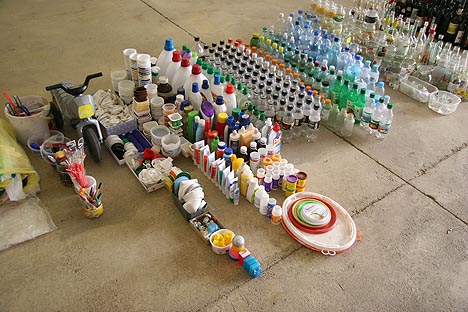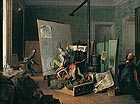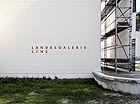
translated and summarized by: Liz Wollner-Grandville,
English summaries August 23 - September 4
Collective
Hans Schabus – Remains of the Day
05.08.11 – 25.09.11
Stiff Upper Lip
I just returned from Britain. And I can tell you that whilst driving on the left side of the road I bumped into a parking car. The owner, a lady who worked in the post office across the street, reacted with a perfect British “stiff upper lip”. With grim assiduousness she didn’t refrain from serving a customer, and - immersed in self-abnegation, imploring total normality.
In 1993, James Ivory set a monument for this mentality with his movie. Anthony Hopkins and Emma Thompson play the impeccable couple that cannot get close to each other, because they are unable to overcome conventions and the stiff upper lip. Both play sophisticated servants serving a Nazi, but the story does not deal with the 1930’s but with the timelessness of controlling one’s impulses. The title of the movie: “Remains of the Day”.
Because I have just returned from Great Britain I can tell you that Hans Schabus is currently presenting a solo-exhibition at the Collective in Edinburgh. The Collective is a producer gallery and the timing is perfect because the highbrow Edinburgh Festival is currently on going, paired with Fringe, the middlebrow alternative event for backpackers. The title of Schabus' installation: "Remains of the Day".
Schabus and his family collected rubbish for an entire year with assiduous self-denial. He kept empty schnapps bottles (quite a number) and red wine bottles (not quite so many), hoarded cigarette buts in plastic buckets and recycled one-way diapers so that they no longer do what their raison d’etre would otherwise be: to smell. He submitted all of these remains of the day and months in the gallery, arranged them product by product, in a long line that fills four rooms, offering pleasure to people with so much practice in queuing.
The accompanying brochure attempts to explain the difference between rubbish and Schabus' arrangement. The difference is art - and therefore rather banal. It is more interesting to consider how Schabus always seems to succeed in reacting to the specifics of a certain location- by setting up a mountain at the Biennale or catacombs in the Secession. Now he approaches the British stiffness with an individual form of regulating one’s existence. Here I again repeat the last word of my review of the artist’s exhibition at the Secession in 2003: magnificent.
By Rainer Metzger
Collective
EH1 1NY Edinburgh, 22-28 Cockburn Street
Tel. +44 131 220 1260
www.collectivegallery.net
Opening hours: Tue – Sun 11 – 17 hours
Unteres Belevedere
Josef Danhauser – Pictorial Narratives
22.06.11 - 25.09.11
Paintings as Novels
Josef Danhauser's paintings speak volumes. His painted library consists of novels, of which some are even based on literary examples. With "The Rich Debaucher", Danhauser, oldest son of a Viennese furniture maker, began his career as a genre painter in 1836. The work not only transposes the well-known biblical parable into the Biedermeier-era, it also illustrates the artist’s attitude to narrating. This is not only the story of a beggar who waits in vain for the crumbs of the rich and - as those well acquainted with the bible know - who is compensated in heaven for his earthly sufferings while the debaucher is punished in Hades for his callousness - there are also a number of other stories, all concealed behind tiny details.
Everyone takes something along that goes far beyond a pure parable and points to today’s universal human values. Nevertheless, the rich man’s dinner partner, dressed in black and obviously in mourning, takes part in the feast. She seems to be the only one who is compassionate, while her partner and the other couple don’t even take note of the beggar – by the by, their mimicry is delightful!
And even the splendid décor tells a story: about the fashion of the “Viennese shawl”, gems of Danhauser's furniture factory (of which he was the artistic director), or about what was considered an exquisite dish at that time in Vienna.
The painting’s counterpart completes the parable in Biedermeier style: "The Soup for the Poor”, completed two years later, reunites some of the protagonists of the "The Rich Debaucher": the rich man obviously has squandered all of his money and now sits across his former butler and the beggar at a soup for the poor. In the background one can see the widow, who, somewhat embarrassed, arm in arm with a new suitor, recognizes her former host. Even the small dog identifies himself with shame with which the punished man now begs for food, while the once ignored beggar offers him some of his own bread.
Danhauser’s position among the Viennese Biedermeier scene was unique. He was unrivalled in his humorous and satirical storytelling style, offering a vast gestural and mimic repertoire, as well as subtle details. Already in 1839, a critic described Danhauser’s works “The Rich Debaucher” and "The Soup for the Poor" as "painted novels" and recognized the relationship to William Hogarth's satirical series, which are partly also presented at the Belvedere. However, the comparison shows that Danhauser never reached Hogarth’s poignancy and probably never strived to do so. This exhibit successfully exposes the seemingly famed Viennese Biedermeier artist and elicits unexpected aspects of his work – such as the perception that Danhauser’s career not only started with a parable, but that his entire oeuvre consists of parables.
By Andrea Winklbauer
Unteres Belvedere
1030 Vienna, Rennweg 6
Tel: +43 1 795 57-200
Fax: +43 1 795 57-121
email: info@belvedere.at
www.belvedere.at
Opening hours: Daily from 10 to 18 hours, Wed: 10 to 21 hours
MAK – Applied Arts / Contemporary Art
Rudolf Steiner – Everyday Alchemy
22.06.11 – 25.09.11
Dornacher ring-shaped cake
Anthroposophy is undoubtedly a phenomenon – for outsiders it is difficult to comprehend its rigidity and for many former Waldorf-students it constitutes an embarrassing part of their youth. Ultimately, the fact that it has remained nearly unchanged in its formal manifestation compared to other intellectually organic life-reform movements at the turn of the century deserves that one takes a closer look. This can be done in the Vitra Design Museum exhibition currently presented at the MAK in commemoration of Rudof Steiner’s 150th birthday.
The exhibition shows Steiner’s tablet drawings, books, manifestos, letters and huge handcrafted furniture monstrosities, whose dimensions could never be mediated in photographs. Analogies to Bohemian architecture Cubism, to Erich Mendelsohn, Frank Lloyd Wright, Bruno Taut, Hans Poelzig, Hugo Häring and Hans Scharous cannot be denied, nor can the theosophical influences by Piet Mondrian, Wassily Kandinsky and Paul Klee; but many of these oeuvres had much to do with Zeitgeist. Not everything that centred on crystals and prisms was created by Steiner. Undoubtedly, his greatest accomplishments are closely tied to the modern visible concrete Goetheaneum building, located in Dornach, Switzerland, which was often compared to a ring-formed cake.
One must consider anthroposophy as a doctrine and not as an artistic style, with more or les arbitrarily binding and therefore not analysable or modifiable parameters. Juxtaposing Steiner's architecture and graphic work with that of contemporary designers and artists is not really convincing - simply because the Zeitgeist is so different now and theosophy and anthroposophy practically no longer influences today's intellectual life. But it is definitely worth seeing in its profound presentation as a now centenary formal cosmos.
MAK-Applied Arts / Contemporary Art
1010 Vienna, Stubenring 5
Tel: +43 (1) 711 36 - o
Fax: +43 (1) 711 36 - 227
www.mak.at
Opening hours: Tue (MAK Nite) 10 – 24 hours, Wed – Sun: 10 – 18 hours
Landesgalerie Linz im OÖ Landesmuseum
Proposals for Venice
26.05.11 - 09.10.11
Intellectual game to think further
Every two years the national art industry takes pleasure in guessing which curator and, later, which artists will be chosen for the Austrian pavilion in Venice. The Landesgalerie Linz invited six curators for the exhibition “Proposals for Venice”, only a few days prior to this year’s vernissage. More than half of the contributions reflect the givens and prerequisites of the world art event whose significance, despite all prophecies of doom (outdated principle of nationalities! Arbitrariness! Demonstration of power!) obviously remains unabated.
Raimar Stange and Andreas Reiter Raabe present a relatively heterogenic mixture of political positions, referring to the different origins of the participants and to their renouncing of the principle of stardom. Therefore, Christine Würmell’s drawings of protestors have their place right next to Elizabeth Peyton’s Obama sticker. G.R.A.M., nominated by Martin Hochleitner, deal with Rudolf Schwarzkogler’s (never implemented) thoughts on the Biennale, Elfie Semotan and Andreas Strauss cover Venetian palazzi with posters that show them on the Biennale compound (invited by Günter Mayer); curator Hemma Schmutz invites to an exchange of ideas in a room gentrified by a mirror by Nicole Six and Paul Petritsch, which was meant to move around the room, but refrained from doing so when I visited the exhibition.
Others distance themselves from discussing the Biennial and don’t show anything one did not expect: Carola Dertnig (invited by Martin Hochleitner) presents photography and text about women and actionism, Edgar Honetschläger (curator: Thorsten Sadowsky) shows lapidary humorous drawings, and Lisl Ponger presents glitzy photographs of political activism. One of the really important questions: challenging the architectural superiority of the Hofmann Pavilion, which any form of art must first of all defy, was left out. While this is commented in an ironical way by Karl-Heinz Klopf's display, it lacks a deeper reflection. Yet the exhibition is by all means an intellectual game that invites to think further.
By Nina Schedlmayer
Landesgalerie Linz am OÖ Landesmuseum
4010 Linz, Museumstrasse 14
Tel: 0732 77 44 82 43
Fax: 0732 77 44 82 66
email: galerie@landesmuseum-linz.ac.at
www.landesgalerie.at
Opening hours: Tue – Fri 9-18 hours, Sat, Sun, Holidays 10-17 hours
Mehr Texte von translated and summarized by: Liz Wollner-Grandville


 Teilen
Teilen





